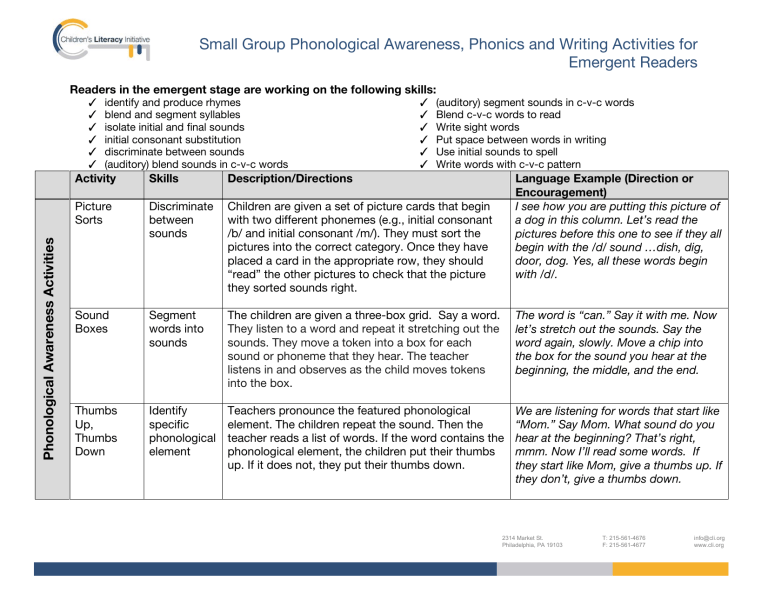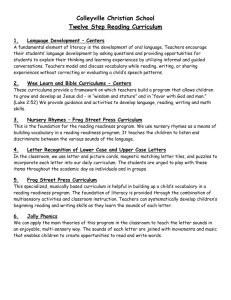
Small Group Phonological Awareness, Phonics and Writing Activities for Emergent Readers Readers in the emergent stage are working on the following skills: Phonological Awareness Activities ✓ ✓ ✓ ✓ ✓ ✓ identify and produce rhymes blend and segment syllables isolate initial and final sounds initial consonant substitution discriminate between sounds (auditory) blend sounds in c-v-c words ✓ ✓ ✓ ✓ ✓ ✓ (auditory) segment sounds in c-v-c words Blend c-v-c words to read Write sight words Put space between words in writing Use initial sounds to spell Write words with c-v-c pattern Activity Skills Description/Directions Language Example (Direction or Encouragement) I see how you are putting this picture of a dog in this column. Let’s read the pictures before this one to see if they all begin with the /d/ sound …dish, dig, door, dog. Yes, all these words begin with /d/. Picture Sorts Discriminate between sounds Children are given a set of picture cards that begin with two different phonemes (e.g., initial consonant /b/ and initial consonant /m/). They must sort the pictures into the correct category. Once they have placed a card in the appropriate row, they should “read” the other pictures to check that the picture they sorted sounds right. Sound Boxes Segment words into sounds The children are given a three-box grid. Say a word. They listen to a word and repeat it stretching out the sounds. They move a token into a box for each sound or phoneme that they hear. The teacher listens in and observes as the child moves tokens into the box. The word is “can.” Say it with me. Now let’s stretch out the sounds. Say the word again, slowly. Move a chip into the box for the sound you hear at the beginning, the middle, and the end. Thumbs Up, Thumbs Down Identify specific phonological element Teachers pronounce the featured phonological element. The children repeat the sound. Then the teacher reads a list of words. If the word contains the phonological element, the children put their thumbs up. If it does not, they put their thumbs down. We are listening for words that start like “Mom.” Say Mom. What sound do you hear at the beginning? That’s right, mmm. Now I’ll read some words. If they start like Mom, give a thumbs up. If they don’t, give a thumbs down. 2314 Market St. Philadelphia, PA 19103 T: 215-561-4676 F: 215-561-4677 info@cli.org www.cli.org Phonics Activities Small Group Phonological Awareness, Phonics and Writing Activities for Emergent Readers Word Sorts Recognize patterns in words Making Words Recognize patterns in words Make and Break Words Onset and rime Mix and Fix Word recognition Word sorts are activities in which children categorize words according to their features. Sorting makes it easier to see the similarities and differences between words. The children are given a set of word cards with two phonics elements (e.g., words with short /a/ and words with short /e/). They must sort the word cards into the correct category. The children are given a set of letter cards (or magnetic letters) to make words (beginning with short words and building to larger words). As children manipulate the letters to make the words, they learn how small changes, such as changing just one letter or moving the letters around, result in completely new words. Children learn to stretch out words and listen for the sounds they hear and the order of those sounds. Give children a set of magnetic letters to make a word family word, such as “bug.” They read the word, running their finger under the letters as they read. (make) After reading the word, have the children identify the onset and rime. Have the children isolate the onset, say the sound, and then say the rime chunk. (break) Reconnect the onset and rime and read the word. (make) Give each child magnetic letters to make a new word (model if necessary). Have them make the word and check it by running their fingers under the word, saying the word slowly and moving left to right under the word. Then have them mix up the letters and fix the word by making it again, following the same procedure. I see that you put “bed” in the “wet” column. Why does “bed” belong in the “wet” column? That’s right, they both have the /e/ sound in the middle. Read the words in the “wet” column. You have made the word “not.” We are going to change one letter in “not” to make the word “nod.” Hmm, what letter would I have to change to make “not” into “nod?” Think about the beginning sound, the middle sound, and the ending sound. Make the word “bug.” Now run your finger under the word and say “bug.” What is the first sound in bug? Slide the letter that makes the /b/ sound away. What letter is it? That’s right, it’s “b.” Read the chunk that is left, -ug. Slide the b back. Read the word. With your letters, make the word “like.” Run your finger under the word and check it. Is it right? How do you know? Now mix it up. Make the word “like” again. 2314 Market St. Philadelphia, PA 19103 T: 215-561-4676 F: 215-561-4677 info@cli.org www.cli.org Writing Activities Small Group Phonological Awareness, Phonics and Writing Activities for Emergent Readers What’s Missing? Word recognition Modeled Writing Word recognition, phonics skills, and composition Shared Writing Word recognition, phonics skills, and composition Interactive Writing Word recognition, phonics skills, and composition Construct a new sight word with magnetic letters on a magnetic board in front of the children. Ask them to read the word with you. Turn the board around and remove one of the letters. Ask the children, “Which letter is missing?” After they give you the missing letter, insert it back into the word. Repeat the procedure several times, removing another letter each time. Modeled writing is when the teacher shows the children how to compose ideas, organize writing, and apply conventions as they write. The teacher models writing a 1-2 sentence response or message. The response will include phonics skills being practiced, so the children can see how they are applied in the context of writing. The message is written in full view of the children. The group reads the completed message together. What is the word? You’re right, it’s “have.” Let’s say it again together. Let’s say the letters in have: h-a-v-e. Now I am going to remove one letter. What’s missing? Yes, the /v/ is missing. What sound does /v/ make? Yes, we hear /v/ in have. Here’s the /v/. Now it says have. So far, I have three words in my sentence, read it with me: The cat has...” Now I am going write “ten.” The first sound is /t/, the letter t makes that sound. The next sound is /e/. The letter e makes that sound. The last sound is /n/, the letter /n/ makes the sound. /t//e/-/n/, ten. The cat has ten hats. Now I’ll write the last word. Shared writing teaches children to apply their word recognition and phonic skills to write a message with support from the teacher. It is an example of “We do” in the gradual release of responsibility. The text is composed together, and the teacher serves as the scribe, writing the message with input from the children on spellings, which allows them to apply phonics skills being taught. The message is 1-2 sentences in length. The teacher and children collaborate to write a response to the text or a message. The text is composed together. The teacher scribes most of the message with input from the children on spellings, which allows them to apply phonics skills being taught. Individual children are called upon to scribe a letter or even a whole word in the message. The message is 1-2 sentences in length. “You hear the /y/, /u/, and /m/ in yummy and you say that you hear an /e/, too. Good listening and thinking. We need to add another /m/ and a /y/ to make yummy. Look! You figured out more than half of the word. Janell, would you like to come up and write the word “get” in our message? You wrote a /g/ at the beginning and a /t/ at the end. So clever of you! Let’s listen to the word again, “get.” What is that sound in the middle? It’s not the short /i/ sound. That’s right, it’s short /e/. Let’s cover this /i/ with correction tape. 2314 Market St. Philadelphia, PA 19103 T: 215-561-4676 F: 215-561-4677 info@cli.org www.cli.org Small Group Phonological Awareness, Phonics and Writing Activities for Emergent Readers Whiteboard Writing Word recognition and phonics skills Table Writing Word recognition and phonics skills Guided Writing Sight word knowledge and decoding The purpose of this activity is to solidify the children’s knowledge of a new sight word. Have the children practice writing the word on white boards. Then have them check it with their finger, saying the word slowly and moving left to right under the word. The purpose of this activity is to solidify the children’s knowledge of a new sight word. Have the children write the new sight word on the table with their finger. The writing movement helps the children to remember the word. Dictate a sentence related to the story that contains some sight words that you have taught and some unknown words. You may also use an open-ended sentence and have students select the last word (e.g., I am a _____.). Suggested guidelines are: Level A: Sentence should be approximately 3-5 words. Level B: Sentence should be approximately 5-7 words. Have the students repeat the dictated sentence several times while you write a line for each word in their journals with a pencil. Transfer the task of writing lines as soon as the students can control the task. Once students are able to space without prompting, the lines will no longer be needed. When the children ask how to spell a word, tell them to say the word slowly and write what they hear. Accept approximations for the unknown words. Previously taught sight words should be spelled correctly. (Richardson, The Next Steps in Guided Reading) Look at word that you’ve written. “Did.” Run your finger under the word and say, “Did.” Does it look right? Do the letters match the sounds? Let’s write the word “not” on the table with our fingers. /n/, /o/, /t/ Read your sentence to me. Look at all of the sounds that you heard in sister. You heard /s/, /t/, / r/. I can see that you said the word slowly and wrote down the sounds that you heard. 2314 Market St. Philadelphia, PA 19103 T: 215-561-4676 F: 215-561-4677 info@cli.org www.cli.org




